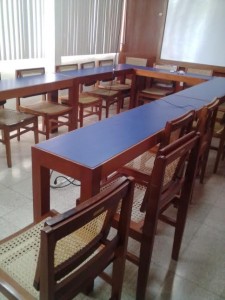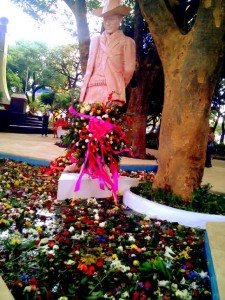In our time abroad, we received many presentations by those making waves of change for human rights in Nicaragua. One of these remarkable folks was Julio Cesar Mena, an organizer working with HIV and AIDS efforts (ANICP + SIDA). Julio contracted AIDS during a blood transfusion while in the army in 1989. Unfortunately he did not realize he was positive until 1993. He shared a powerfully emotional and vulnerable story of also infecting his girlfriend and his daughter, who passed of AIDS at the age of 8 years old. When he discovered he was positive, medications weren’t yet available in the country of Nicaragua. He had to travel to Guatemala and took 90 pills a day for three years… an astounding 30 pills a meal.

Cesar translating for Julio as he demonstates the 5 pills he takes a day now in comparison to 90.
“I want to continue to struggle. I want to continue to live.”
He was given until 1998 to live but has persevered and works every day to focus on the human rights of those that are HIV positive or are living with AIDS, prevention, education, and to alleviate stigma. Six years ago, he weighed 60 pounds and his meds were $800 a month but are now free. Surprisingly, the current Nicaraguan administration is the first to acknowledge the problem and buys 20% of the medications while the rest are supplied by a global fund (Bill Gates is a larger donor). The movement towards greater inclusion on issues of the virus is greatly rejected by the Catholic and Evangelical churches. The stigma is so great that if one enters the hospital and claims to be HIV positive, they will be systematically served last. One can also be fired for being HIV positive, and commonly are. Julio shared that in Nicaragua, 9/10 families would reject those that are positive. On the Atlantic coast, people believe that just looking at or hugging someone can give them AIDS. As you can see, there is a lot of work to be done.
According to the Ministry of Health, 2 people get infected with HIV in Nicaragua every day. The Ministry also claims that about 10,000 people are HIV positive in Nicaragua but Julio estimates the number are closer to 30 or 40,000. He shared, “Three people died of AIDS last week…mostly because of lack of attention and medicine and sometimes people just give up.” The Ministry of Education refuses to take on the task of AIDS education and prevention measures. Historically 90% of those infected with HIV were men but now a change has swept through and those that are positive are predominantly women (those taking care of the home). Julio claims that like the States, gay males and sex worker populations are at a higher risk of contracting HIV. However, I was surprised to learn that most living positive in Nicaragua are heterosexuals. He shared that most straight people were afraid to come out and the gay community falsely keeps the majority of the stigmatization. The main mode of transmission is via intercourse and there isn’t a lot of maternal transmission to child. I also found it interesting to note that an increase in tourism has added transmission to the sex workers.
The organization that Mr. Mena works for is located in Managua with 320 active members. There are 11 people working in the office that go to the hospitals and provide home visits to those that are ill. They also facilitate workshops and support groups every Thursday. There are 6 satellite offices throughout Nicaragua with 1,120 HIV positive members total. Their program also does outreach to hospitals with pamphlets so that people know where to find them and what services are available. They also work closely with sex workers to teach proper condom use and techniques for negotiations to use them during sexual activity. They also try to work to get youth involved in prevention, a task they’re struggling with. A great inspiration, Julio Cesar Menas has been trying to facilitate greater change by requesting to meet with the government for at least 5 years. His goals are to make the government more inclusive of those that are living with HIV and AIDS in the workforce and to allow participation in production of the country.



